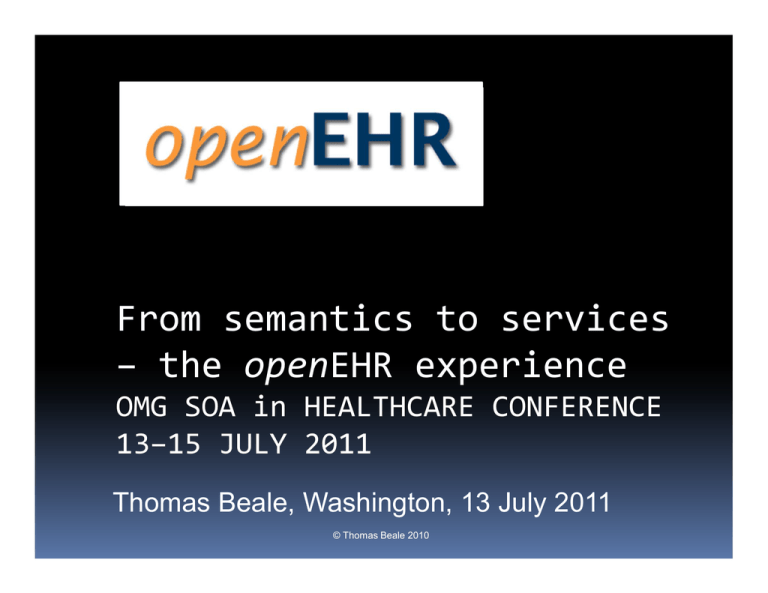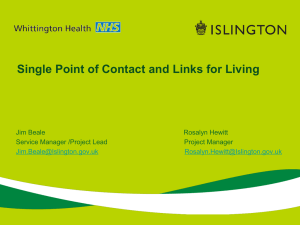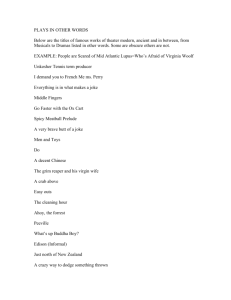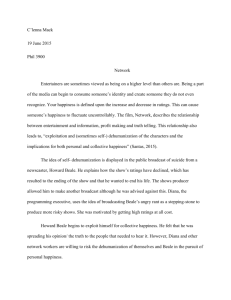From semantics to services – the openEHR experience 13–15 JULY 2011
advertisement

From semantics to services
– the openEHR experience
OMG SOA in HEALTHCARE CONFERENCE
13–15 JULY 2011
Thomas Beale, Washington, 13 July 2011
© Thomas Beale 2010
What are we trying to do
today?
© Thomas Beale 2011
Ultimate ICT goals
• To Compute with health information
• Cross-enterprise
• Patient-centric
• Over time & technology changes
© Thomas Beale 2011
Ultimate ICT goals
• In particular:
• X-enterprise patient care pathway tracking
• Decision support for doctors
• Business process analysis for provider orgs
• Business intelligence for payers & public health
• Medical research ‘study’ analysis
• Person-centred data analysis, ethically targetted
marketing etc
• Integrate health data with social & educational
media streams in patient-centred portals
© Thomas Beale 2011
Ultimate ICT goals
• While dealing with relentless change in
• Medicine, esp. drugs, interactions, procedures...
• Information
• Care processes
• Patient needs
• Legislation
© Thomas Beale 2011
Getting there requires...
A ~change-immune semantic architecture,
allowing
meaning of information and healthcare process
steps etc to be safely and reliably defined
convertability of information from proprietary /
legacy sources to common formats
© Thomas Beale 2011
Getting there requires...
A systems and services architecture defining
groupings and access protocols enabling:
Aggregation of information from source systems
Varying levels of conformance, esp. for existing
systems
Incremental deployment
Satisfying changing business needs
© Thomas Beale 2011
Assumptions
A services architecture with no semantic
underpinning can deliver:
Human – human information transmission
Very basic search facilities
Limited computability, where information is
already widely standardised, e.g. HL7v2 lab, ADT
Some security / privacy support
But not generalised patient-centric
computability – can’t access the main
economic potential
© Thomas Beale 2011
The clock is ticking...
Today we are still creating peta-bytes of non-
interoperable, non-computable health data
Post-hoc ‘re-engineering’ of the data to make
it computable is too expensive to be realistic
We know this because medical research
projects regularly burn their entire budget on
data re-engineering
© Thomas Beale 2011
The semantic part
© Thomas Beale 2011
Historical Industry Structure
Stds orgs +
Professional
bodies
DOCs & Patients
GOVs / MoHs
Proprietary
form definitions
docs
terminology
VENDOR / INTEGRATOR
GUI
...use systems
Present’n
data
dictionaries
code
APPS
&
SYSTEMS
Msg
specs
XSD
...manual
Write docs,
create message
specs
... Write data
specs, minimum
data sets,
schemas for DS,
referral etc
...consume
documents and
msg specs
© Thomas Beale 2011
developers
... make up
what they
don’t
understand
PROVIDERS
Buy (poor)
Solutions
Historical Industry Structure
Stds orgs +
Professional
bodies
DOCs & Patients
GOVs / MoHs
Proprietary
form definitions
docs
terminology
VENDOR / INTEGRATOR
GUI
...use systems
Present’n
data
dictionaries
code
APPS
&
SYSTEMS
Msg
specs
XSD
...manual
Write docs,
create message
specs
... Write data
specs, minimum
data sets,
schemas for DS,
referral etc
...consume
documents and
msg specs
© Thomas Beale 2011
developers
... make up
what they
don’t
understand
PROVIDERS
Buy (poor)
Solutions
openEHR approach
Stds orgs +
Professional
bodies
DOCs & Patients
GOVs / MoHs
VENDOR / INTEGRATOR
terminology
GUI
templates
Operational
template
T
O
O
L
Present’n
TDO
archetypes Collaborative
knowledge
repository
TOOL
build archetypes
& terminology that
define their
Information –
e.g. via IHTSDO
TOOL
...build templates
and issue as
standards
e.g. Discharge
Summary
templates
...use systems
APIs
&
Services
XSD
Platform
TOOL
...consume
std templates and
create their own,
making OPTs
© Thomas Beale 2011
TOOLS
developers
build
SOLUTIONS
based on
the platform
PROVIDERS
buy
Solutions
openEHR approach
Stds orgs +
Professional
bodies
GUARANTEED
SEMANTICS
GOVs / MoHs
VENDOR / INTEGRATOR
terminology
GUI
templates
archetypes
TOOL
build archetypes
And terminology
that define their
Information –
e.g. via IHTSDO
Collaborative
knowledge
repository
TOOL
Operational
template
T
O
O
L
templates
DOCs & Patients
...use systems
Present’n
TDO
APPS
&
SYSTEMS
XSD
Platform
TOOL
...build templates
...consume
and issue as
std templates and
standards
create their own,
Knowledge engineering
e.g. Discharge
making OPTs
Summary
© Thomas Beale 2011
TOOLS
developers
PROVIDERS
build
buy
SOLUTIONS Solutions
Software engineering
based on
the platform
The basic plan
A general theoretical paradigm or framework
An architecture specific to the domain,
including
Actual specifications for formalisms, models etc
Actual models
© Thomas Beale 2011
The openEHR framework
Use-case specific
data-set definitions
Templates
1:N
Portable,
model-based
queries
© Thomas Beale 2011
Snomed CT
Defines all data
Querying
ICDx
Reference Model
Terminologies
ICPC
All possible
item
Archetypes
definitions
1:N
for health
Terminology
interface
Defined connection
to terminology
openEHR Archetype
© Thomas Beale 2011
AQL query
SELECT com2/context/start_time/value as START_DATE,
obs1/data[at0001]/events[at0006]/data[at0003]/items[at0004]/value/magnitude as
SYSTOLIC,
obs1/data[at0001]/events[at0006]/data[at0003]/items[at0005]/value/magnitude as
DIASTOLIC,
obs3/data[at0002]/events[at0003]/data[at0001]/items[at0004]/value/magnitude as
PULSE_RATE,
obs4/data[at0001]/events[at0002]/data[at0003]/items[at0004]/value/magnitude as
RESPIRATORY_RATE....
FROM EHR e[ehr_id/value='f271cd26-23fc-43a1-b411-34cdadaea067'] CONTAINS
COMPOSITION com2 [openEHR-EHR-COMPOSITION.encounter.v1]
CONTAINS (OBSERVATION obs3 [openEHR-EHR-OBSERVATION.heart_rate-pulsezn.v1] OR OBSERVATION obs1 [openEHR-EHR-OBSERVATION.blood_pressure-zn.v1]
OR OBSERVATION obs4 [openEHR-EHR-OBSERVATION.respiration.v1] ....
WHERE com2/name/value matches {'Vital functions', 'Respiratory assessment',
'Assessment scales'} AND obs9/name/value = 'PEF before' AND obs10/name/value =
'PEF after' AND com2/context/start_time >= '20110406T000000.000+0200' AND
com2/context/start_time < '30000101T000000.000+0100'
© Thomas Beale 2011
Properties - software
Generated
software
Developed
software
Generate
Templates
1:N
Consume
Terminology
interface
Terminologies
Archetypes
Software core
© Thomas Beale 2011
Snomed CT
Reference Model
ICDx
Querying
ICPC
1:N
The architecture
java
Int’l
Nat’l / local Nat’l / local
archetypes archetypes templates
C#
Templatebased
artefacts
etc
re
f
s
e
ts
terminology
All data = same information model
© Thomas Beale 2011
Querying
canonical
openEHR
data
The key...
Is the operational
s
e
template (OPT) – this
is the joining point
between the
semantic
specifications and
deployable software
artefacts that can be
used by normal
developers
ts
Evaluate inclusions,
flatten constraint
inheritance
© Thomas Beale 2011
Key Outcomes
Normal developers can engage – openEHR +
Snomed become economic and ~quick
Semantic connection exists between definitions
and implementations
now we know what the meaning of data are, and
DS and BI can work...
© Thomas Beale 2011
The openEHR framework
Templates
1:N
Terminology
interface
Terminologies
Archetypes
© Thomas Beale 2011
Snomed CT
Reference Model
ICDx
Querying
ICPC
1:N
The reference model
Will continue to grow, to accommodate
process, workflow etc
EHR
EHR Extract
Demographics
Composition
Security
Party
Participations
Audit
Versioning
Data Structures
Data Types
Primitive types, Ids
http://www.openehr.org/releases/1.0.2/roadmap.html
© Thomas Beale 2011
The openEHR framework
Templates
1:N
Terminology
interface
Terminologies
Archetypes
© Thomas Beale 2011
Snomed CT
Reference Model
ICDx
Querying
ICPC
1:N
The archetype architecture
Downsteam software artefact transformations
Template model & serialisations
Archetype Query
Language (AQL)
Archetype Object
Model (AOM)
Archetype Def.
Language (ADL)
Data Types
Primitive types, Ids
http://www.openehr.org/releases/1.0.2/roadmap.html
© Thomas Beale 2011
Managing knowledge artefacts
Content models & terminology ref sets
managed outside of software process &
people
Needs:
Governance
Methodology
Identification
Sharing and release rules
etc
© Thomas Beale 2011
Clinical Knowledge Manager
A tool for involving clinicians in defining
clinical content based on archetypes,
templates, and termsets
© Thomas Beale 2011
CKM Core Principles
Separation of technical and clinical aspects to
successfully involve clinicians in
•
Informal Discussions
•
Formal Reviewing (content, terminology
binding, translations)
•
Sharing
•
Publishing
•
Revision/Version Management
•
Release and Dependency Management
© Thomas Beale 2011
CKM Approach
Web 2.0 design
Easier to engage clinicians: Can now use 5 mins or
1 hour of an expensive specialised clinician's time;
before, they lost hours on physical meetings
Implementation is growing as we learn
Can respond quickly to changing needs, evolving
methodology
More than a tool
Engage and manage the community
© Thomas Beale 2011
CKM Users
International openEHR CKM instance
> 630 users
From 64 countries
National programs with an instance of CKM
Australia: Nehta
Sweden: SKL
© Thomas Beale 2011
Key Messages
Knowledge Management is crucial
High-quality archetypes with high-quality clinical
content
Semantically interchangeable between clinical
systems; also the basis for decision support
Key to success: how to engage with clinicians and
capture their knowledge
CKM - http://www.openehr.org/knowledge
© Thomas Beale 2011
Key Outcomes
We can now start to situate existing standards
in the framework
Concrete content-specific standards like HL7
message definitions, CDAs, CCRs etc are
DOWNSTREAM generations and/or mappings of
operational templates
Meaning we can connect them into a semantic
framework and potentially guarantee their semantics
Rather than manually building them in a standalone
fashion
© Thomas Beale 2011
Tool-based standards
java
C#
etc
re
f
s
e
ts
terminology
Querying
data
© Thomas Beale 2011
The Services Part
© Thomas Beale 2011
Old view…
patient
PAYER
Secondary
users
portal
Allied
health
other
provider
HILS
Imaging lab
PAS
DSS
UPDATE
QUERY
Enterprise
Path lab
notifications
Msg gateway
Comprehensive Basic
Patient
Record
identity
Multimedia
genetics
EHR
Clinical
ref data
Clinical
models
Interactions DS
Local
modelling
Online drug,
Interactions DB
terms
guidelines
protocols
Online
terminology
Online
archetypes
© Thomas Beale 2011
LAB
workflow
realtime
gateway
demographics
Online
Demographic
registries
ECG etc
billing
telemedicine
General approach
Build from bottom up – ‘Native’ services
Needed services, consistent with information and
model artefacts
And from top-down – ‘Standard’ services
Connect IHE, HSSP etc to native services
© Thomas Beale 2011
Services
java
C#
etc
r
e
f
s
e
N
a
t
i
v
e
t
s
terminology
Querying
data
© Thomas Beale 2011
I
H
E
H
S
S
P
On Services...
Some architectural inspiration from Microsoft
Connected Health Framework (CHF)
Native layer
Take as much of IHE, HSSP etc interfaces & adapt
for native compatibility, making archetype-aware
Standards layer
Service – service connection
© Thomas Beale 2011
Microsoft CHF
ProcessModels
Service Models
Information Models
© Thomas Beale 2011
EHR Service
Workflow & Pathway Services
demographics
Security & privacy
© Thomas Beale 2011
The openEHR services architecture
http://www.openehr.org/wiki/display/spec/openEHR+Service+Model
© Thomas Beale 2011
Native services
All services archetype/template aware
Query service based on AQL / a-path
No SQL queries against physical database!!!
© Thomas Beale 2011
Key data services - EHR
ARCHETYPE-AWARE
Virtual EHR – fine-grained creation,
modification, retrieval, querying
EHR back-end – coarse-grained DVCS-like
interface – ‘change-set’ based
EHR audit log
© Thomas Beale 2011
Key data services - patient
Demographics – ARCHETYPE-AWARE
Authentication info
Patient relationships
HCP relationships – teams etc
EHR subject X-ref service
openEHR EHRs are identified by EHR id only
Deals with merged & split EHRs, i.e. 2 subject ids
1 EHR, 2 EHR ids 1 subject
Enables dynamic distribution of EHRs
Becoming the EHR meta-data service
© Thomas Beale 2011
Key knowledge services
Archetypes & templates
Terminology ref-sets
Terminology service
access
Inferencing
Terminology administration
Medications, devices
Allergies & interactions database
© Thomas Beale 2011
Key process services
Event-based notifications
Care pathway
Based on archetyped openEHR structures
Booking / appointments
Requires access to patient requests & doctor’s
diary & other resource availability data
Doctor’s diary
Forces syncing of appointments to filler
Patient diary
Allows multi-function visits
© Thomas Beale 2011
Key elements that MUST WORK
Standardised querying of data, based on
knowledge artefacts, not physical DB
standardised knowledge artefact identification,
including versions
standardised ability to designate finest grain
items in the data
Enabling URI to any data item
© Thomas Beale 2011
Key elements that MUST WORK
Everything in openEHR relies on archetype
paths, which are X-path compatible
The two tests are being able to:
Write portable queries
Create URIs to finest grain of data
© Thomas Beale 2011
AQL query
SELECT com2/context/start_time/value as START_DATE,
obs1/data[at0001]/events[at0006]/data[at0003]/items[at0004]/value/magnitude as
SYSTOLIC,
obs1/data[at0001]/events[at0006]/data[at0003]/items[at0005]/value/magnitude as
DIASTOLIC,
obs3/data[at0002]/events[at0003]/data[at0001]/items[at0004]/value/magnitude as
PULSE_RATE,
obs4/data[at0001]/events[at0002]/data[at0003]/items[at0004]/value/magnitude as
RESPIRATORY_RATE....
FROM EHR e[ehr_id/value='f271cd26-23fc-43a1-b411-34cdadaea067'] CONTAINS
COMPOSITION com2 [openEHR-EHR-COMPOSITION.encounter.v1]
CONTAINS (OBSERVATION obs3 [openEHR-EHR-OBSERVATION.heart_rate-pulsezn.v1] OR OBSERVATION obs1 [openEHR-EHR-OBSERVATION.blood_pressure-zn.v1]
OR OBSERVATION obs4 [openEHR-EHR-OBSERVATION.respiration.v1] ....
WHERE com2/name/value matches {'Vital functions', 'Respiratory assessment',
'Assessment scales'} AND obs9/name/value = 'PEF before' AND obs10/name/value =
'PEF after' AND com2/context/start_time >= '20110406T000000.000+0200' AND
com2/context/start_time < '30000101T000000.000+0100'
© Thomas Beale 2011
openEHR URI
ehr:1234567/87284370-2D4B-4e3d-A3F3F303D2F4F34B@latest_trunk_version/
content[openEHR-EHR-SECTION.vital_signs.v1]/
items[openEHR-EHR-OBSERVATION.heart_ratepulse.v1]/data/events[at0006, 'any event']/
data/items[at0004]
© Thomas Beale 2011
Where paths come from
© Thomas Beale 2011
Conclusions
© Thomas Beale 2011
Basic premise
If we want to share and compute with health
data at any level of detail, we need a
knowledge-based architecture
© Thomas Beale 2011
Architecture
Semantic underpinning
Knowledge-enabled
services
java
C#
etc
r
e
f
s
e
Connect
to standards
t
s
terminology
Querying
data
Model-based
querying
© Thomas Beale 2011
N
a
t
i
v
e
I
H
E
H
S
S
P
Services lessons
Need native and standard layers, i.e.
Inside-out, outside-in
Knowledge-based architecture brings new
needs:
New knowledge services – archetypes, ref-sets
Other services must be knowledge-aware
Business services need to be small, with
changeable interfaces
© Thomas Beale 2011
Knowledge awareness means...
Service layer understands:
knowledge artefact identification system
Fine-grained data item identification
Which means we need standardised
knowledge models
Aka DCMs
© Thomas Beale 2011
The ultimate test
If you can create a URI to ‘my instantaneous
resting, lying down systolic BP, recorded
7/jan/2011’ then you can communicate at any
level of detail about health information
© Thomas Beale 2011






